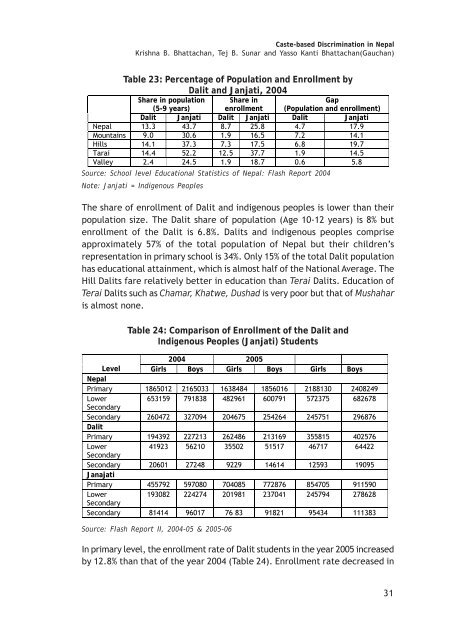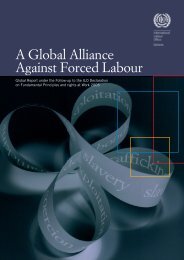Caste-based discrimination in Nepal - International Dalit Solidarity ...
Caste-based discrimination in Nepal - International Dalit Solidarity ...
Caste-based discrimination in Nepal - International Dalit Solidarity ...
Create successful ePaper yourself
Turn your PDF publications into a flip-book with our unique Google optimized e-Paper software.
<strong>Caste</strong>-<strong>based</strong> Discrim<strong>in</strong>ation <strong>in</strong> <strong>Nepal</strong><br />
Krishna B. Bhattachan, Tej B. Sunar and Yasso Kanti Bhattachan(Gauchan)<br />
Table 23: Percentage of Population and Enrollment by<br />
<strong>Dalit</strong> and Janjati, 2004<br />
Share <strong>in</strong> population<br />
(5-9 years)<br />
Share <strong>in</strong><br />
enrollment<br />
Gap<br />
(Population and enrollment)<br />
<strong>Dalit</strong> Janjati <strong>Dalit</strong> Janjati <strong>Dalit</strong> Janjati<br />
<strong>Nepal</strong> 13.3 43.7 8.7 25.8 4.7 17.9<br />
Mounta<strong>in</strong>s 9.0 30.6 1.9 16.5 7.2 14.1<br />
Hills 14.1 37.3 7.3 17.5 6.8 19.7<br />
Tarai 14.4 52.2 12.5 37.7 1.9 14.5<br />
Valley 2.4 24.5 1.9 18.7 0.6 5.8<br />
Source: School level Educational Statistics of <strong>Nepal</strong>: Flash Report 2004<br />
Note: Janjati = Indigenous Peoples<br />
The share of enrollment of <strong>Dalit</strong> and <strong>in</strong>digenous peoples is lower than their<br />
population size. The <strong>Dalit</strong> share of population (Age 10-12 years) is 8% but<br />
enrollment of the <strong>Dalit</strong> is 6.8%. <strong>Dalit</strong>s and <strong>in</strong>digenous peoples comprise<br />
approximately 57% of the total population of <strong>Nepal</strong> but their children’s<br />
representation <strong>in</strong> primary school is 34%. Only 15% of the total <strong>Dalit</strong> population<br />
has educational atta<strong>in</strong>ment, which is almost half of the National Average. The<br />
Hill <strong>Dalit</strong>s fare relatively better <strong>in</strong> education than Terai <strong>Dalit</strong>s. Education of<br />
Terai <strong>Dalit</strong>s such as Chamar, Khatwe, Dushad is very poor but that of Mushahar<br />
is almost none.<br />
Table 24: Comparison of Enrollment of the <strong>Dalit</strong> and<br />
Indigenous Peoples (Janjati) Students<br />
2004 2005<br />
Level Girls Boys Girls Boys Girls Boys<br />
<strong>Nepal</strong><br />
Primary 1865012 2165033 1638484 1856016 2188130 2408249<br />
Lower<br />
653159 791838 482961 600791 572375 682678<br />
Secondary<br />
Secondary 260472 327094 204675 254264 245751 296876<br />
<strong>Dalit</strong><br />
Primary 194392 227213 262486 213169 355815 402576<br />
Lower<br />
41923 56210 35502 51517 46717 64422<br />
Secondary<br />
Secondary 20601 27248 9229 14614 12593 19095<br />
Janajati<br />
Primary 455792 597080 704085 772876 854705 911590<br />
Lower<br />
193082 224274 201981 237041 245794 278628<br />
Secondary<br />
Secondary 81414 96017 76 83 91821 95434 111383<br />
Source: Flash Report II, 2004-05 & 2005-06<br />
In primary level, the enrollment rate of <strong>Dalit</strong> students <strong>in</strong> the year 2005 <strong>in</strong>creased<br />
by 12.8% than that of the year 2004 (Table 24). Enrollment rate decreased <strong>in</strong><br />
31

















